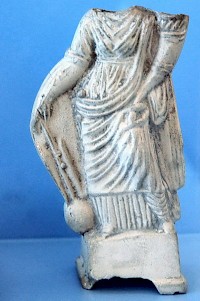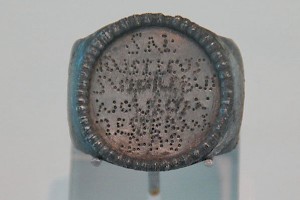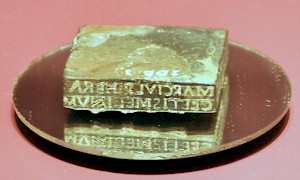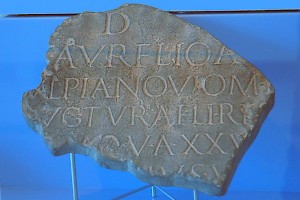Nijmegen, Ulpia Noviomagus
Q1309708Nijmegen: city in the Netherlands, where several Roman settlements have been discovered.
Origins

After the Batavian Revolt (69-70), the Romans ordered the surviving inhabitants of Batavodurum to move a bit to the west, and build a new city. The name of the new town was Noviomagus, Celtic for the "new market"; the name of the old town, Batavodurum, can be read as "market of the Batavians" (or "Batavian stronghold").
Its remains were found underneath the Waterkwartier, a part of Nijmegen west of the railroad, and south of the river Waal. From a Roman point of view, Noviomagus remained a small town of some 5,000 inhabitants; but from a local perspective, it must have been a big city. It was too large to be fed from the hinterland; grain and other food had to be imported. An inscription has been found that mentions the Nervian grain trader Marcus Liberius Victor (more).
The city

Because Noviomagus was close to the river, its northern wall has been washed away. And because it is situated beneath a modern living quarter, excavation is difficult. Still, two temples in native style have been excavated, and archaeologists were able to establish that the Romans, when they built these sanctuaries in c.100, did not hesitate to remove older buildings to create sufficient room to build them.
They were adjacent to each other and dedicated to related gods: Fortuna and Mercury, both protectors of trade and prosperity. They received the normal sacrices: goats, sheep, cocks, fish, and precious figs and dates, which must have been imported. A ring that was dedicated to Salus has been taken as evidence that this deity was also venerated over here.
No remains of the sanctuaries are visible, but the pavement of the Maasplein 24-28 and IJsselstraat 9-13 has two colors, indicating the sites of the ancient temples. White lines in the nearby Maasplein square indicate the place where a villa has been excavated.

A bit to the east of these temples, we can find the artisans' quarter, which initally produced for export, but after the mid-second century concentrated on producing for the local market. Possibly, the demand from the Hunerberg fortress had seriously fallen. More to the north, the bathhouse has been identified (no remains visible). A third temple is suspected in the northwestern corner of Noviomagus; in 1834, laborers have removed remains of "rock" from that place, which may in fact have been the foundation of natural stone of a sanctuary or another important public building. To the east of Noviomagus were the bridge and the river port.

The cemetery was identified to the south of the city and along the road to the Hunerberg fortress, which was about 2¾ kilometer to the east of the civil settlement. The splendid glass vase that is one of the best known pieces of the Valkhof Museum, was found on this cemetery, at a stone's throw from the museum itself. It must have been the property of a really wealthy family.
The really impressive finds, however, were done on the southern cemetery, where, between some 12,500 cremation tombs, several extremely rich tombs must have stood. Their foundations, surrounded by little walls, measured about 4x5½ meter, which suggests that these monuments were real towers of some twelve to fifteen meter high. The tomb of the Secundinii from Igel and the tomb of Lucius Poblicius in Cologne give an idea about what the Nijmegen mausoleums must have looked like. They date back to the last quarter of the first century, or the first years since the founding of Noviomagus. Among the gifts are precious pieces of crystal and amber. In the second and third centuries, people started to be buried in coffins, a custom that had, until then, only existed in the Near East.
 Nijmegen, Amber portait of a girl |
 Nijmegen, Crystal ring |
 Nijmegen, Crystal dice |
 Nijmegen, Amber carving of Amor |
Market rights?

It has been claimed that Nijmegen received market rights at the beginning of the second century, because it was named Ulpia Noviomagus. The first element is a reminder of the name of the emperor (Marcus Ulpius Trajanus, or simply Trajan); the second element, does indeed mean "new market", but (a) it is unlikely that the city received its new name at another moment than its founding, and (b) cannot indicate that the city received the right of nundinas habere ("to organize markets"). As capital of the Batavians, the town already had the privilege of organizing markets as early as the days of Agrippa. That Trajan has done anything special for the city, except for allowing the citizens to use his family name, is a misunderstanding that continues to bedevil the study of Roman Nijmegen.
What probably happened is that Nijmegen changed its name twice. First, the town was rebuilt in the west, near the Waal, and was renamed Noviomagus; later, the emperor Trajan awarded the surname Ulpia. To the best of the present author's knowledge, there are no examples of towns that simultaneously changed their main name and received a surname. Usually, honorific surnames like Claudia, Flavia, and Aelia were given to cities that were already well-known and could no longer simply change their name.
Demise
During the reign of Emperor Marcus Aurelius, the pressure on the frontier started to increase. In 173, the Chauci, a Germanic tribe that lived along the shores of the Wadden Sea and had a reputation for piracy, unexpectedly invaded the country that is now called Flanders. The governor of Belgica, Didius Julianus, defeated the looters, but the invasion must have come as a shock.

For the first time, Noviomagus received city walls. Blue tiles in the Bronsgeeststraat and the Victor, indicate the site of the wall and the ditch in the south and east. The northern wall will never be found, because it has been destroyed by the Waal, but the western wall was identified in the autumn of 2008. The ditch was ten meter wide and about three meter deep; the walls may have been about five meter high. Oddly enough, the western wall turned out not to be parallel to the eastern wall; the city was not a square, as one would have expected from a Roman city. During these excavations, the archaeologists also found the remains of an exceptionally large building, about eighty meter long and seven meter wide.
In c.180, the city suffered from a disastrous fire. The temples and the bathhouse were never rebuilt. It is tempting to believe that this was the consequence of a Germanic raid, but evidence for violence is missing.
Probably, Noviomagus suffered heavily from the Frankish invasion of 275, which put an end to the Roman presence in the lower Rhine area for almost a generation. After 300, we find people living at the old river port, and we know that this city was called Noviomagus, but what happened between 275 and 300, is not known, although it is certain that the dead were no longer cremated but buried. This is a normal change, butin Nijmegen, it started exceptionally early.
 Nijmegen, Maasplein: site of the Roman villa |
 Nijmegen, Maasstraat: site of a Roman temple. |
 Nijmegen, IJsselstraat: Site of a Roman temple. |
 Nijmegen, Voorstadslaan: site of the cemetery |